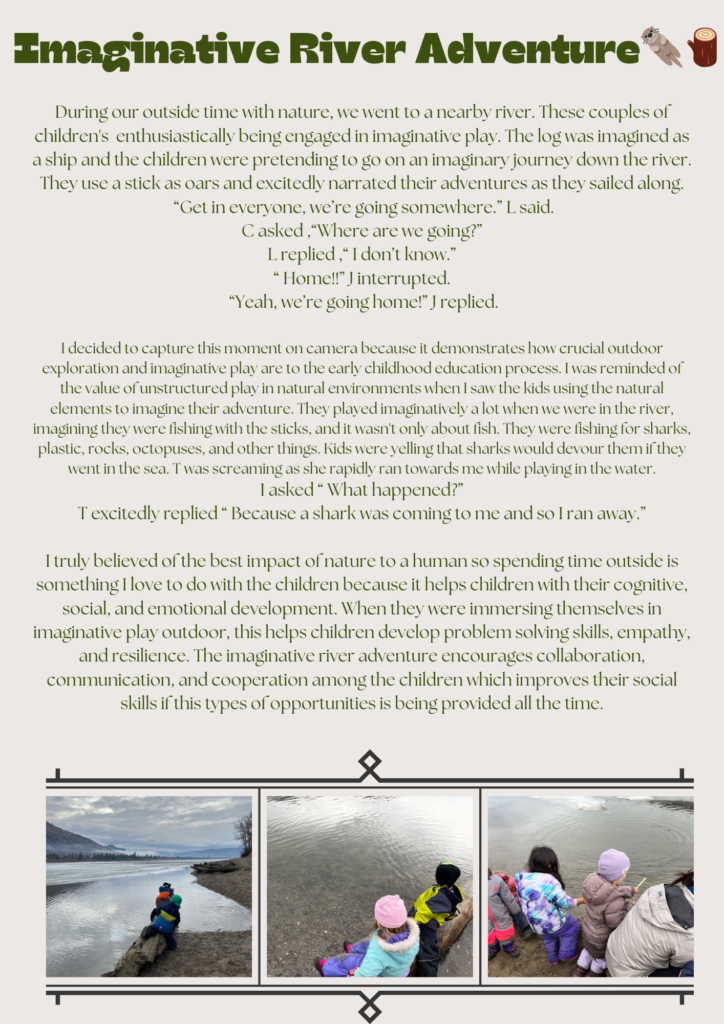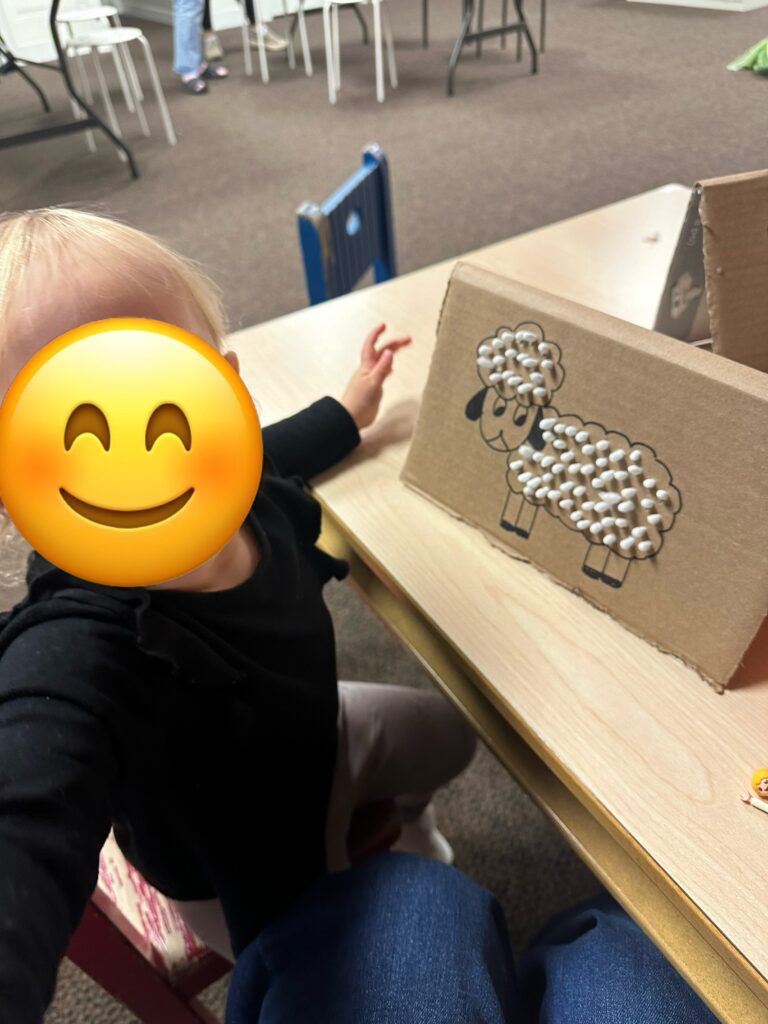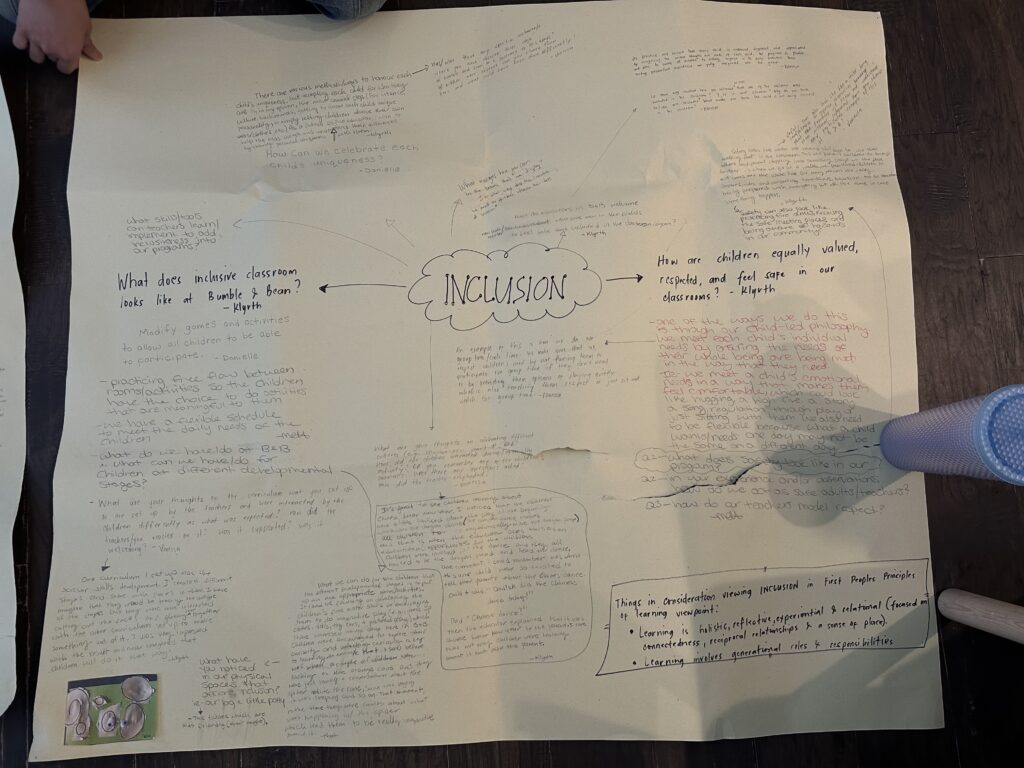Year 1- Practicum 1 and 2 pedagogical documentation
Example: Exploring Materials
Example: Imaginative River Adventure

Child a said, “Is the spider hibernating because it’s cold right now?”

“Teacher, can I read you this book?” L asked.

Lunar New Year 2024

Final Practicum(year 2)

“Educators are Researchers and Collaborators” (BCELF, p.17&18). I noticed kids often use the word “ thank you”. Thanksgiving was nearing as well so I got an idea to ask some kids if they know what thanksgiving is since it’s a celebration of harvest and other blessings. Being thankful for all the good things in your life and being with your loved ones. After asking the question, some kids answered yes and some answered no. Therefore, I collaborated with other educator about my plan to teach children during my circle time relating to thanksgiving, fall and being thankful. During my circle time, I asked the children…
“What are you thankful for?” After teaching them about thanksgiving and having a better understanding of what the word thankful means.
“Teacher, I am thankful to play with Cass”
“I am thankful for the brand new people”
“I am thankful for everyone”
“Marry my mom. I like my mom”
These are some of the responses. Having to know what they are thankful for. It creates conditions where children build connections to the world around them. It engages them in thinking more deeply and expressing themselves, recognizing their reciprocal relationship with people and places. To get children to connect more or understand a little bit of the educators in the center. I also included educators by asking who they are thankful for.
“What about the teachers? What are you thankful for?” I asked.
“I am thankful to be a part of the B&B community”
“I am thankful for the gift of life”
“ I am thankful for the mentors”- D, a practicum student
I thought this was a significant moment because it taught the kids what their teachers are grateful for, and it taught the teachers what the kids are grateful for. This creates an inclusive atmosphere as it visualizes each child feeling safe to participate and to think without feeling uncomfortable. I wanted to promote inclusion, building relationships, and to provoke more complex thinking during this group time.
The process of making the hand print was enjoyable and fulfilling to the children. I watched them excitedly asking me to trace their hands. The design was created by each child. They designed it however they wanted. I would listen and hear the children say
“I want to use only the color pink feather teacher,” L said.
“Why only pink? There’s lots of different colors like green, blue, orange” I asked.
“because I like pink,” L replied.
Other child wanted to only put eyes on the hand print because it looked “Cool and creepy”
Some wanted to put all the colors because they wanted it to become as colorful as they can, like a rainbow. As a practicum student, this truly helps me recognize the children and their efforts in a way they view things. It brought joy as they explored through the materials and slowly built the art they wanted.

Walk to the Zoo 🐏🐑🦫

“Teacher, he likes me” P said.
“How do you know it likes you?” I asked.
“Because he stays with me” P answered.
When I lead the walk to the zoo, I reminded/front-loaded the kids what the expectation was when we’re in the space(zoo). The first thing was not to harm the animals, not running away from the teacher and always being respectful to the space and other people. P understood the whole point and walked off to pet the goat. She used her gentle hand and asked questions to the goat like,
“ Are you friends with me?” Then gave the goat a kiss with excitement when the goat stayed with her for a long time. Observing P staying with the goat. I could see that she really likes and love that the goat was accompanying her, although there was other children handing food. P built relationships to her surroundings and create meaningful relationship to the land and the animal.

The group of children I went on a walk with consisted of both new and older children. Visiting the zoo helped facilitate interaction between the children; for instance, when younger children engaged in behaviors such as throwing rocks at the animals, older children would remind them of the rules. The children also inquired of one another, asking questions like where the mother llama was located, and younger children would indicate different animals saying “here.”

“I did it!” Cotton sheep
As I positioned myself next to a very active and inquisitive 2.5-year-old girl, I was inherently joyous as for she delighted in the task of pushing massive cotton sticks through holes. Whenever she achieved it, it was as though she has never done it in her life and would scream with excitement, “ I did it!”
You could tell she was becoming more and more self-assured every single time she put in another cotton stick. That was such an incredible moment for me because it finally dawned on me that she was actually gaining a delight that was so little, and yet so profound all at the same time. Perhaps even more than I would have been on account of the fact that she was tremendously proud of accomplishing the goal and walked up to shout her success not only to me but – quite additionally, to other educators later. She was filled with joy even more when I told her about the good news along with her mother who was equally ecstatic.
There was a moment when she called on me, and I approached her with a piece of the cotton and encourage her by saying ‘You can do it!’. Though she felt tired at some point, with a little encouragement she would start feeling determined to finish her work again. Eventually, I retreated to my original position which was watching her, and every time she reported achieving a success, I cheerfully would say “You did it!” Until she finished up.

and here is when she finished putting all the cotton sticks. She called out to me saying “teacher, I finished it!” With a proud face on her.

Pedagogical narration in the field
The image below, shows my pedagogical narration with the conversation and observation from the children in my practicum. This was a Q & A between me and the educators. Specifically, about inclusion and what I have learned and noticed from the space and how I take that observation and make somethings from my pedagogical commitment.

Giving responsibility to the children
Whenever children finishes up eating, we would have the dustpan and broom ready for the children that wants to clean up after themselves. Giving out responsibilities like cleaning up after themselves fosters independence and self-reliance. Children learn how to take care of themselves and I noticed, these build their independence and confidence in their ability to manage tasks. Sometimes, other children would offer to help the other kids to clean up which shows us great leadership skills. When we give them responsibility, children understand the consequences of their actions such as making a mess and take ownership of their actions. Promoting a sense of accountability in a positive way.
Cleaning-after-themselves-